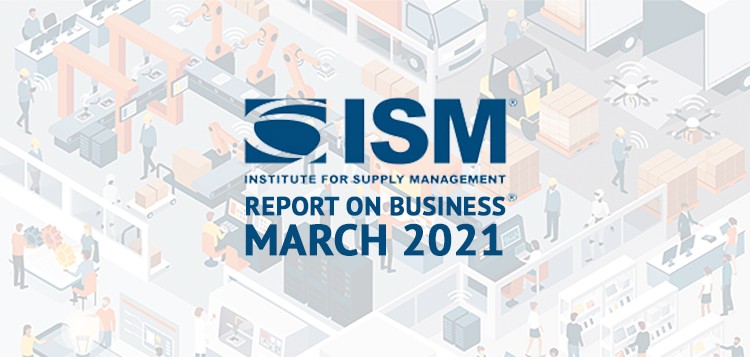Manufacturing Growth Reaches Near-40-Year High According to March PMI®

The release of the March 2021 Manufacturing ISM® Report On Business® comes with plenty of fanfare this month, as manufacturing growth reaches a 37-year high. The Manufacturing PMI® for the month came in at an impressive 64.7, rebounding nearly four points from February. This figure puts the PMI at its highest point since December 1983. It’s a sign manufacturing has moved beyond recovery and into expansion territory. But this growth isn’t without impending challenges, and industry executives predict turbulence in tandem with growth.
March shows growth across the board
Virtually every core metric tracked by the Manufacturing ISM rose in March. Employment led the way, gaining 5.7 points, followed by production, which kicked up 4.9 points. New orders and order backlog both rose by more than 3 points, alongside supplier deliveries, which gained 4.6 points. The only metric with any real measure of contraction was exports, which fell 2.7 points.
These figures signal a continuation of 10-month trends, stemming from the beginning of the COVID-19 recovery in May of 2020. This near-40-year high signals burgeoning growth from industry as we enter a pivotal time in domestic economic development. The economy is growing, and for the first time in decades, manufacturing is leading the charge.

Burgeoning industry faces obstacles
Despite attractive numbers in the Manufacturing ISM, manufacturing could be in for struggles ahead. At least, manufacturing executives feel that way. Samplings from the Report on Business illuminate concerns about the speed of expansion and the inability of industry to keep pace.
“Widespread supply chain issues. Suppliers are struggling to manage demand and capacity in the face of chronic logistics and labor issues. No end in sight.” (Machinery)
“Business bottomed out in February; we are expecting steady improvement through the end of the year. Inflation and material availability, along with logistics, are major concerns.” (Furniture & Related Products)
In simpler terms, business is booming for manufacturing, but there is such a thing as too much business. With concerns stemming from commodity costs, lack of talent, and supply chain delays, there’s fear that headwinds will blow stronger than tailwinds. Manufacturers could soon feel the pressure of too much, too fast — especially with a Biden Administration infrastructure plan rooted heavily in manufacturing.

Is pent-up inflation a concern?
There’s also concern that manufacturing’s concerted uptrend is an omen for inflation on the horizon. Commodity shortages, higher prices, and the rising costs of production will slowly trickle into the broader economy, bringing with them concerns about the value of the dollar.
The last time the manufacturing PMI reached this level, inflation neared 4%, which is high above the Federal Reserve’s public target of 2%. Economic markers suggest inflation could spike in the near future, driven largely by manufacturing’s current woes. The bond market already reflects this sentiment, with treasury yields up significantly from the prior year.
In the current moment, manufacturing is showing strength in a pandemic that’s nearing the end of its run. Sustained growth at this rate could quickly spill over into a whole new realm of challenges for manufacturers struggling to keep up with demand. While rising numbers are a sign of a positive trend, what industry really needs now is stability in the form of a plateau.